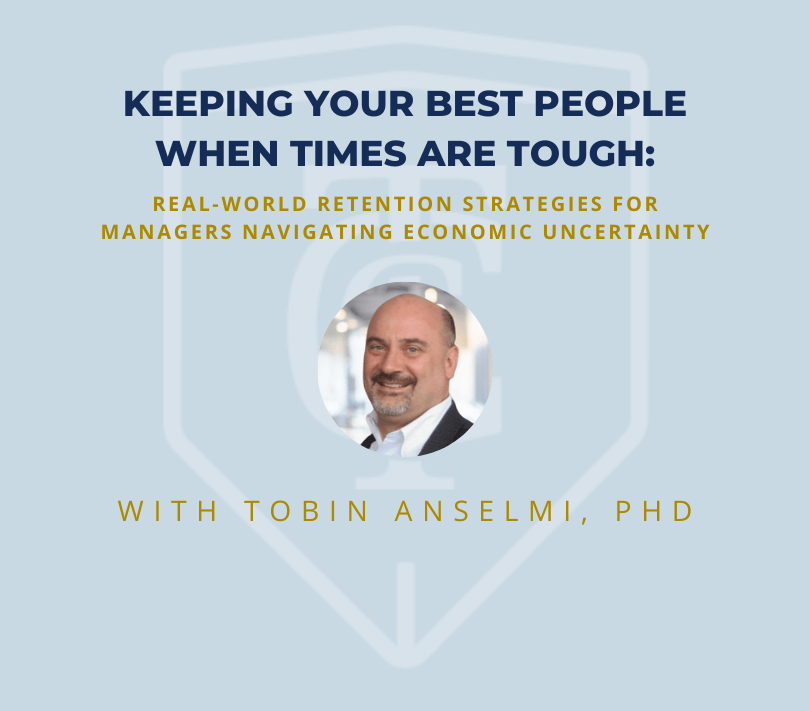
Let’s be honest: the last couple of years have been a bit of a mess economically. Prices are up, budgets are tight, and it feels like every week brings a new curveball. And while we as leaders are doing our best to steer through it all, the truth is, our teams are feeling it just as much, if not more.
In uncertain times, people naturally start to wonder: Is my job safe? Should I start looking elsewhere? As someone who’s spent a career focused on talent, I can tell you, this is exactly when leadership matters most. It’s not about adding perks or overpromising stability. It’s about showing up, building trust, and making people feel like they’re seen, supported, and part of something that still makes sense, even when everything else doesn’t.
The strategies below aren’t theory, they’re lessons learned from years of leading through change. Pick what fits, adapt it to your team, and remember: retention isn’t a project. It’s a relationship.
- Talk Straight—and Talk Often
Your team hears the same news you do. They know inflation is real. They know supply chains are a mess. If we don’t give them context, they’ll make up their own stories, and those stories usually involve layoffs.
You don’t have to have all the answers. What you do need is honest, regular communication. Share what you know, admit what you don’t, and explain how it all connects to their day-to-day work. Something as simple as: “Because of the tariffs, we’re seeing supplier costs spike. That’s why we’re adjusting timelines, but the process improvements you led last quarter are helping us manage. That’s real impact.”
And don’t just talk at them, talk with them. Ask what’s on their mind. I’ve done plenty of “stay interviews” that turned out to be turning points for both employees and teams. They’re not just HR’s job. Ask questions like, What’s keeping you here? or What’s making your job harder lately?—and actually listen. You’ll learn what matters most to your people, and you’ll often catch issues before they grow legs.
But here’s the thing, you need support to do this well. Your leaders have to give you the information you need. Without clear messaging or strategic direction, we’re left filling in the blanks. That’s not fair to you, or your team.
- Take Care of Your People First
People are stressed. Rising living costs, work uncertainty, personal pressures, it adds up fast. We can’t solve all of that, but we can lead with empathy.
Check in regularly, one-on-one. Not just about deadlines or tasks—ask how they’re doing. Not every conversation needs to be heavy, but just showing you care makes a difference. Questions like “What’s one thing I could take off your plate this week?” or “What’s been weighing on you?” can open the door to trust.
Encourage people to use support resources like EAPs. And if there’s a stigma around them, help normalize it. Take your own vacation days. Don’t send emails at 11 p.m. Your team takes their cues from you.
Again, this only works if the organization backs it. That means real investment in well-being programs, flexible work policies, and training for managers to spot burnout before it hits crisis levels. Most of us aren’t therapists, and we shouldn’t try to be, but we can be steady, caring points of contact in someone’s work life.
- Keep Growth on the Table, Even in Lean Times
One of the fastest ways to lose good people? Let them feel stuck.
In tough times, development might feel like a luxury, but it’s actually a retention tool. People don’t leave jobs where they see a future.
Ask your team what they want to learn. Ask where they want to grow. Maybe someone wants to get better at data analysis. Maybe someone’s eyeing a leadership path. Even if promotions aren’t available right now, stretch assignments, shadowing opportunities, or small learning commitments, like a LinkedIn course, can go a long way.
Make it practical. Ten minutes of learning a day is better than nothing. I’ve seen employees light up just from knowing someone sees their potential. If you’ve got access to development tools, use them. And if you don’t, ask for them. Leaders say they want to retain top talent? Then give us the budget and platforms to invest in their growth.
- Give Feedback That Connects
In uncertain times, feedback becomes a lifeline. When people don’t know how they’re doing, or how their work fits into the bigger picture, they disengage.
Keep it simple, frequent, and specific. “Hey, that update you made to the client pitch deck saved us a ton of back-and-forth. Great call.” Positive feedback isn’t fluff, it’s fuel. And when you give it publicly? It builds team culture fast.
Don’t wait for annual reviews to set goals. Use SMART goals to create short-term clarity. When people know what success looks like, even if everything else is changing, they feel more confident and grounded.
Ask your org for better tools if you need them, whether it’s software to track goals or training on how to give tough feedback that lands well. None of us come out of the gate being great at this. It’s a skill. And it’s one that pays off fast.
- Build a Team People Want to Be Part Of
At the end of the day, people stay where they feel like they belong. Not just because of the paycheck, but because they’re part of something that matters.
Make sure your team knows how their work connects to the company’s mission. Whether you’re selling software or staffing a hospital, tie the daily grind to the bigger picture. People want to know their work means something.
Create space for everyone’s voice. Encourage quieter team members to speak up. Diversity of thought isn’t just nice, it drives better results. And don’t underestimate the power of a team lunch, a Slack shoutout, or a quick virtual hangout. These small moments build connection, especially in hybrid or remote setups.
And again, it only works if leadership is modeling it from the top. A mission without action is just a poster on the wall. We need our leaders to invest in culture the same way they invest in strategy.
Practical Next Steps for Managers
Step 1: Take your team’s pulse.
Do a few one-on-ones. Run a quick team check-in. What are people worried about? Where are the bright spots?
Step 2: Spot growth opportunities.
Even one course or stretch assignment can reignite someone’s energy.
Step 3: Communicate like clockwork.
Share updates every two weeks, even if it’s just, “Here’s what I know, here’s what I don’t.”
Step 4: Watch for signs of burnout.
Ask your HR team for metrics. Engagement scores, turnover spikes, EAP usage—all of it tells a story.
Step 5: Celebrate wins, big and small.
A five-minute “win round” in a team meeting can lift morale more than you’d think.
What Organizations Need to Do
If we want managers to retain top talent, we can’t do it alone. Companies need to step up, too.
- Give us the tools to track engagement, log feedback, and plan development.
- Train us in the soft skills that make a hard impact, empathy, communication, feedback.
- Fund the programs, EAPs, learning platforms, team-building resources, that show employees they matter.
- Offer flexibility so we can support people as people, not just performers.
- Be transparent with strategy and vision, so we can keep our teams aligned and informed.
Retention isn’t about gimmicks or grand gestures. It’s about consistency, care, and connection. In times like these, people don’t just want stability, they want to feel like they matter. As managers, we’re in a unique position to give them that. And when we do it well, they don’t just stay, they grow. So start small. Be human. Be present. And lead in a way that reminds people they’re not just surviving this season, they’re part of something worth sticking around for.
About Tobin Anselmi
 Tobin Anselmi joined The Christopher Group Consulting Services Division in 2020 as a Managing Partner & Talent Management Practice Leader. Tobin holds a Ph.D. in I/O Psychology. Over the last 30+ years, Tobin has served as a consultant to organizational leadership on human capital management issues such as talent management (selection, performance management, development, and movement), organizational effectiveness, change management, and leadership development. He is direct, engaging, and result-oriented. His practical recommendations to organizational issues are grounded in years of experience developing and implementing solutions around the globe. To learn more about Tobin visit his bio page.
Tobin Anselmi joined The Christopher Group Consulting Services Division in 2020 as a Managing Partner & Talent Management Practice Leader. Tobin holds a Ph.D. in I/O Psychology. Over the last 30+ years, Tobin has served as a consultant to organizational leadership on human capital management issues such as talent management (selection, performance management, development, and movement), organizational effectiveness, change management, and leadership development. He is direct, engaging, and result-oriented. His practical recommendations to organizational issues are grounded in years of experience developing and implementing solutions around the globe. To learn more about Tobin visit his bio page.

